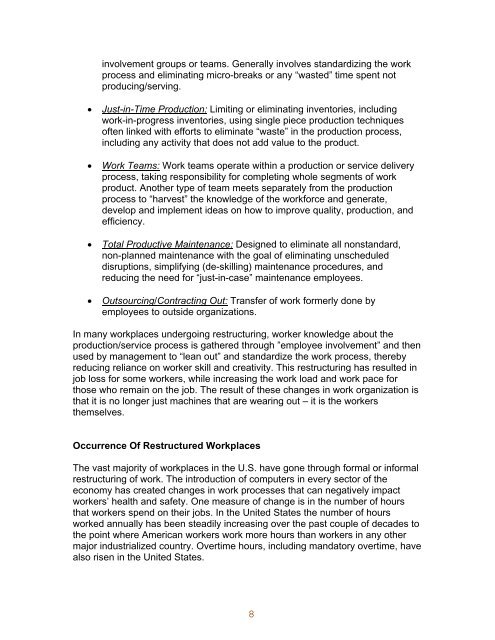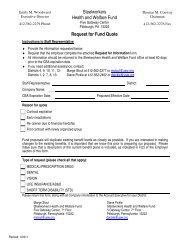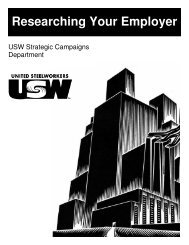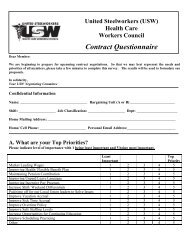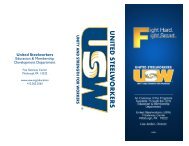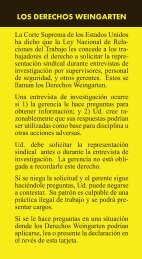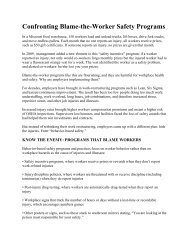Union Approach to Health and Safety: - United Steelworkers
Union Approach to Health and Safety: - United Steelworkers
Union Approach to Health and Safety: - United Steelworkers
You also want an ePaper? Increase the reach of your titles
YUMPU automatically turns print PDFs into web optimized ePapers that Google loves.
involvement groups or teams. Generally involves st<strong>and</strong>ardizing the work<br />
process <strong>and</strong> eliminating micro-breaks or any “wasted” time spent not<br />
producing/serving.<br />
<br />
<br />
<br />
<br />
Just-in-Time Production: Limiting or eliminating inven<strong>to</strong>ries, including<br />
work-in-progress inven<strong>to</strong>ries, using single piece production techniques<br />
often linked with efforts <strong>to</strong> eliminate “waste” in the production process,<br />
including any activity that does not add value <strong>to</strong> the product.<br />
Work Teams: Work teams operate within a production or service delivery<br />
process, taking responsibility for completing whole segments of work<br />
product. Another type of team meets separately from the production<br />
process <strong>to</strong> “harvest” the knowledge of the workforce <strong>and</strong> generate,<br />
develop <strong>and</strong> implement ideas on how <strong>to</strong> improve quality, production, <strong>and</strong><br />
efficiency.<br />
Total Productive Maintenance: Designed <strong>to</strong> eliminate all nonst<strong>and</strong>ard,<br />
non-planned maintenance with the goal of eliminating unscheduled<br />
disruptions, simplifying (de-skilling) maintenance procedures, <strong>and</strong><br />
reducing the need for “just-in-case” maintenance employees.<br />
Outsourcing/Contracting Out: Transfer of work formerly done by<br />
employees <strong>to</strong> outside organizations.<br />
In many workplaces undergoing restructuring, worker knowledge about the<br />
production/service process is gathered through ”employee involvement” <strong>and</strong> then<br />
used by management <strong>to</strong> “lean out” <strong>and</strong> st<strong>and</strong>ardize the work process, thereby<br />
reducing reliance on worker skill <strong>and</strong> creativity. This restructuring has resulted in<br />
job loss for some workers, while increasing the work load <strong>and</strong> work pace for<br />
those who remain on the job. The result of these changes in work organization is<br />
that it is no longer just machines that are wearing out – it is the workers<br />
themselves.<br />
Occurrence Of Restructured Workplaces<br />
The vast majority of workplaces in the U.S. have gone through formal or informal<br />
restructuring of work. The introduction of computers in every sec<strong>to</strong>r of the<br />
economy has created changes in work processes that can negatively impact<br />
workers’ health <strong>and</strong> safety. One measure of change is in the number of hours<br />
that workers spend on their jobs. In the <strong>United</strong> States the number of hours<br />
worked annually has been steadily increasing over the past couple of decades <strong>to</strong><br />
the point where American workers work more hours than workers in any other<br />
major industrialized country. Overtime hours, including m<strong>and</strong>a<strong>to</strong>ry overtime, have<br />
also risen in the <strong>United</strong> States.


